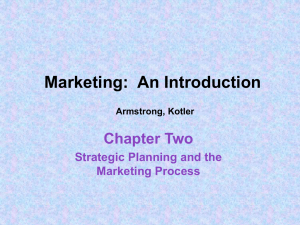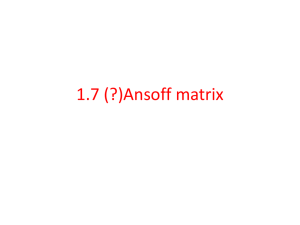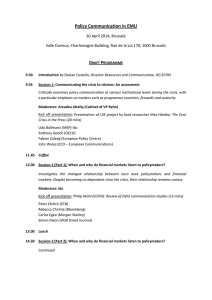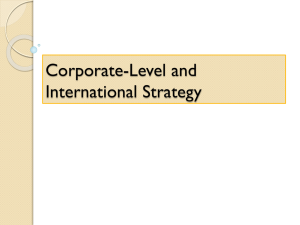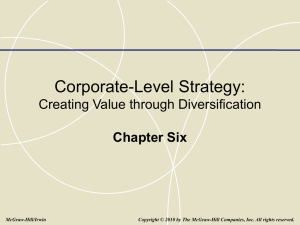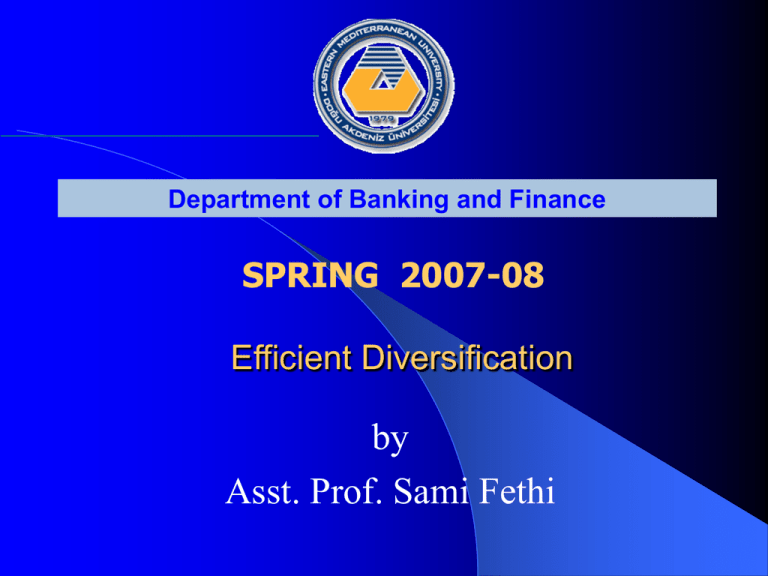
Department of Banking and Finance
SPRING 2007-08
Efficient Diversification
by
Asst. Prof. Sami Fethi
Ch 6: Efficient Diversification
Diversification and Portfolio risk
Recall: portfolio is a collection of assets and
risk is the chance of financial loss.
What are the sources of risk affecting a portfolio?
1) The first type risk is associated with general
economic conditions such as the business cycle, the
inflation rate, interest rate, exchange rate and so
forth.
None of them are predicted with certainty so all
conditions affect a company’s the rate of return.
2
Investment Management
© 2007/08 Sami Fethi, EMU, All Right Reserved.
Ch 6: Efficient Diversification
Diversification and Portfolio risk
2) The second one is the firm-specific factors that
affect a firm without noticeably affecting other
firms.
If you have one stock in your portfolio, this means
that you cannot reduce risk factor. However, you
need to consider a diversification strategy such as
naïve diversification half of your portfolio in a
company and leaving the other half in an other
company. This precaution reduce portfolio risk.
3
Investment Management
© 2007/08 Sami Fethi, EMU, All Right Reserved.
Ch 6: Efficient Diversification
Diversification and Portfolio risk
For instance, If you invest half of your risky
portfolio in Mobil company and leaving the other
half in Dell company, what happens to portfolio
risk?
Assume that if computer prices increases, this helps
Dell company and when oil prices fall, this hurts
Mobil company.
The two effects are offsetting which stabilizes
portfolio return.
4
Investment Management
© 2007/08 Sami Fethi, EMU, All Right Reserved.
Ch 6: Efficient Diversification
Diversification and Portfolio risk
When all risk is firm-specific, diversification can
reduce risk to low level. This reduction of risk to
very low levels because of independent risk
sources is called the insurance principle.
When common sources of risk affect all firms,
even extensive diversification cannot eliminate
risk. Graphically, as portfolio standard deviation
falls, the number of securities increases, but it is
not reduced to zero.
5
Investment Management
© 2007/08 Sami Fethi, EMU, All Right Reserved.
Ch 6: Efficient Diversification
Diversification and Portfolio risk
The risk that remains even after diversification is
called market risk. This risk is attributable to
market-wide risk sources. They are also called
systematic or non-diversifiable risk.
The risk that can be eliminated by diversification is
called unique risk, firm-specific risk, nonsystematic risk, or diversifiable risk.
It is important to note that portfolio risk decreases
as diversification increases.
6
Investment Management
© 2007/08 Sami Fethi, EMU, All Right Reserved.
Ch 6: Efficient Diversification
Diversification and Portfolio risk
Graphically Presented
7
Investment Management
© 2007/08 Sami Fethi, EMU, All Right Reserved.
Ch 6: Efficient Diversification
Diversification and Portfolio risk
Graphically Presented
8
Investment Management
© 2007/08 Sami Fethi, EMU, All Right Reserved.
Ch 6: Efficient Diversification
Asset allocation with two Risky Assets
Portfolio risk depends on the correlation between
the returns of the assets in the portfolio.
Asset allocation across the three key asset classes:
stocks, bonds, and risk-free money market
securities.
Example 1: suppose there are three possible
scenarios for an economy: a recession period, a
normal growth period, and a boom period. The
stock fund will have a rate of return of –11% in
recession, 13% in normal period and 27% in boom
period.
9
Investment Management
© 2007/08 Sami Fethi, EMU, All Right Reserved.
Ch 6: Efficient Diversification
Example 1 cont..
Suppose that a bond fund will provide ROR of
16% in the recession, 6% in the normal period and
–4% in the boom period. What is the expected or
mean return for both stock and bond funds?
The expected return on each fund equals the
probability-weighted average of outcomes in the
scenarios.
The variance is the probability-weighted average
across all scenarios of the squared deviation
between the actual returns of the fund and its
expected return.
10
Investment Management
© 2007/08 Sami Fethi, EMU, All Right Reserved.
Ch 6: Efficient Diversification
Capital market expectations for the
stock and bond
stock fund
(A)
(B)
(C)
stock fund bond fund bond fund
(D)
(E)
(F)
Col. B
Scenario
Probability
Recession
Normal
0.3
0.4
Boom
0.3
Expected
Return =
Expected
Col. B
Rate of
´
Rate of
´
Return
Col. C
Return
Col. E
-11
13
-3.3
5.2
16
6
4.8
2.4
27
8.1
-4
-1.2
sum
10
sum
6
11
Investment Management
© 2007/08 Sami Fethi, EMU, All Right Reserved.
Ch 6: Efficient Diversification
Example 2
Suppose, we form a portfolio with 60% invested
in the stock fund and 40% in the bond fund.
Calculate portfolio return in recession
portfolio return in each scenario is the weighted
average of the returns on the two funds.
Calculate portfolio return in recession =
0.60 (-11%) + 0.40 (16%)
-0.20%
12
Investment Management
© 2007/08 Sami Fethi, EMU, All Right Reserved.
Ch 6: Efficient Diversification
Covariance and correlation
If we compute the probability-weighted average of
the products across all scenarios, we obtain a
measure of the extent to which the returns tend to
vary with each other, that is to co-vary, it is called
the covariance.
The negative value for the covariance indicates that
the two asset vary inversely, that is when one assets
performs well, the other tends to perform poorly.
It is really difficult to interpret the magnitude of
covariance. An easier statistics to interpret is the
correlation coefficient.
13
Investment Management
© 2007/08 Sami Fethi, EMU, All Right Reserved.
Ch 6: Efficient Diversification
Covariance and correlation
The correlation coefficient is simply defined as the
covariance divided by the product of the standard
deviation of the returns on each fund.
Correlation coefficient (ρ)= covariance/ σSTOCK σBOND
Correlation can range from values of –1 to 1.
Correlation of zero indicate that the returns on the
two assets are unrelated to each other.
Positive correlated shows two series move in the
same direction while negative moves in opposite
directions.
14
Investment Management
© 2007/08 Sami Fethi, EMU, All Right Reserved.
Ch 6: Efficient Diversification
Let us have the following table which shows covariance
between the returns of the stock and bond funds:
A
1
2
3
4
5
6
7
Scenario
Recession
Normal
Boom
Variance
8
st.dev=SQRT(Var)
B
Probability
0.3
0.4
0.3
C
ROR
-11
13
27
D
E
Stock fund
Stock fund
F
G
H
I
Bond fund
Bond fund
J
Dev from m re SQ DEV
-21
3
17
B xE
ROR Dev from m re SQ DEV B x I
132.3 16
10
30
441
100
9
3.6 6
0
0
0
86.7 -4
-10
30
289
100
222.6
60
sum
sum
14.92
7.75
15
Investment Management
© 2007/08 Sami Fethi, EMU, All Right Reserved.
Ch 6: Efficient Diversification
Let us have the following table which shows covariance
between the returns of the stock and bond funds:
(A)
(B)
1
2 Scenario
3 Recession
4 Normal
(C)
(D)
(E)
(F)
Deviation from mean return
Deviation from mean return
Probability
0.3
0.4
0.3
5 Boom
6
7 correlation coefficient
stock fund
bond fund Prod of dev
-21
10
3
17
0
-10
covariance
-210
BXE
-63
0
-170
0
-51
sum
-114
-0.99
16
Investment Management
© 2007/08 Sami Fethi, EMU, All Right Reserved.
Ch 6: Efficient Diversification
Correlation coefficient
The correlation coefficient is simply defined as the
covariance divided by the product of the standard
deviation of the returns on each fund.
Correlation coefficient (ρ)=covariance/ σSTOCK σBOND
=-114/(14.92x7.75)
i.e.,(-21)2x(0.3)+(3)2x(0.4)+(17)2x(0.3)=SQRT of VAR=14.92
i.e.,(-10)2x(0.3)+(0)2x(0.4)+(-10)2x(0.3)=SQRT of VAR=7.75
=-0.99
This confirms the overwhelming tendency of the
returns on the stock and bond funds to vary
inversely in the scenario analysis.
17
Investment Management
© 2007/08 Sami Fethi, EMU, All Right Reserved.
Ch 6: Efficient Diversification
Example 3
The rates of return of the bond portfolio in the
three scenarios based on the previous table are
10% in a recession, 7% in a normal period, and
2% in a boom. The stock returns in the three
scenarios are –12% (recession), 10% (normal),
and 28% (boom). What are the covariance and
correlation coefficient between the rates of return
on the two portfolios?
18
Investment Management
© 2007/08 Sami Fethi, EMU, All Right Reserved.
Ch 6: Efficient Diversification
Example 3
(A)
Scenario
(B)
Probability
(C)
(D)
(E)
Stock fund
Col. B
ROR
(F)
Bond Fund
ROR
Col. B
´
Col. E
´
Col. C
Recession
Normal
Boom
0.3
0.4
0.3
-12
10
-3.6
4
28
8.4
8.8 sum
Expected or mean return
Sum
(A)
(B)
(C)
(D)
Stock fund
Scenario
Recession
Normal
Boom
Probability SQ De Mea
0.3
0.4
0.3
2
0.6
6.4
(E)
Bond Fund
Col. B
SQ De Mea
´
Col. E
12.96
0.36
3.888
0.144
386.64
110.592
19.36
5.808
240.96 sum
9.84
15.52
(B)
(F)
129.792
0.576
Stdev
(A)
3
2.8
432.64
1.44
sum
Variance
Col. B
´
Col. C
10
7
(C)
(D)
3.14
(E)
(F)
Deviation from mean return
Covariance
Scenario
Recession
Normal
Boom
Probability
0.3
0.4
0.3
correlation coefficient
stock fund
-20.8
1.2
19.2
bond fund
Prod of dev
3.6
-74.88
0.6
0.72
-4.4
-84.48
covariance
sum
BXE
-22.464
0.288
-25.344
-47.52
-0.98
19
Investment Management
© 2007/08 Sami Fethi, EMU, All Right Reserved.
Ch 6: Efficient Diversification
Two-Security Portfolio: Return
rp = W1r1 + W2r2
W1 = Proportion of funds in Security 1
W2 = Proportion of funds in Security 2
r1 = Expected return on Security 1
r2 = Expected return on Security 2
n
S
Wi = 1
i=1
20
Investment Management
© 2007/08 Sami Fethi, EMU, All Right Reserved.
Ch 6: Efficient Diversification
Two-Security Portfolio: Risk
sp2 = w12s12 + w22s22 + 2W1W2 Cov(r1r2)
s12 = Variance of Security 1
s22 = Variance of Security 2
Cov(r1r2) = Covariance of returns for
Security 1 and Security 2
21
Investment Management
© 2007/08 Sami Fethi, EMU, All Right Reserved.
Ch 6: Efficient Diversification
Two-Security Portfolio
E(rp) = W1r1 + W2r2
sp2 = w12s12 + w22s22 + 2W1W2 Cov(r1r2)
sp = [w12s12 + w22s22 + 2W1W2 Cov(r1r2)]1/2
22
Investment Management
© 2007/08 Sami Fethi, EMU, All Right Reserved.
Ch 6: Efficient Diversification
Example 4
Suppose that for some reason you are required to
invest 50% of your portfolio in bonds and 50% in
stocks. r1=6%, r2=10%, σ1=12%, σ2=25%, w1=0.5,
and w2=1-0.5=0.5.
A) If the standard deviation of your portfolio is
15%, what must be the correlation coefficient
between stock and bond returns?
B) What is the expected rate of return on your
portfolio?
23
Investment Management
© 2007/08 Sami Fethi, EMU, All Right Reserved.
Ch 6: Efficient Diversification
Example 4
A) sp2 = w12s12 + w22s22 + 2W1W2 s12
152= (0.5x12)2+ (0.5x25)2 +2 (0.5x12)
(0.5x25) s12
s12=0.21183
B) E (rp) = W1 E (r1)+ W2 E (r2)
= (0.5x6)+ (0.5x10)
= 8%
24
Investment Management
© 2007/08 Sami Fethi, EMU, All Right Reserved.
Ch 6: Efficient Diversification
Covariance
Cov(r1r2) = r1,2s1s2
r1,2 = Correlation coefficient of
returns
s1 = Standard deviation of
returns for Security 1
s2 = Standard deviation of
returns for Security 2
25
Investment Management
© 2007/08 Sami Fethi, EMU, All Right Reserved.
Ch 6: Efficient Diversification
Correlation Coefficients: Possible Values
Range of values for r 1,2
-1.0 < r < 1.0
If r = 1.0, the securities would be perfectly
positively correlated
If r = - 1.0, the securities would be perfectly
negatively correlated
26
Investment Management
© 2007/08 Sami Fethi, EMU, All Right Reserved.
Ch 6: Efficient Diversification
Three-Security Portfolio
r p = W1 r 1 + W2 r 2 + W 3 r 3
s2p = W12s12
+ W 2 2 s 22
+ W3 2 s 3 2
+ 2W1W2 Cov(r1r2)
+ 2W1W3 Cov(r1r3)
+ 2W2W3 Cov(r2r3)
27
Investment Management
© 2007/08 Sami Fethi, EMU, All Right Reserved.
Ch 6: Efficient Diversification
In General, For an n-Security Portfolio:
rp = Weighted average of the
n securities
sp2 = (Consider all pair-wise
covariance measures)
28
Investment Management
© 2007/08 Sami Fethi, EMU, All Right Reserved.
E(r)
Ch 6: Efficient Diversification
TWO-SECURITY PORTFOLIOS WITH
DIFFERENT CORRELATIONS
The
13%
r = -1
r=0
r = .3
r=1
8%
figure
shows
the
opportunity set with perfect
positive correlation. No portfolio
can be discarded as inefficient
and the choice among portfolios
depends only on risk preference.
Diversification in the case of
perfect positive correlation is not
effective.
Perfect
positive correlation is
the only case in which there is no
benefit from diversification.
In
the case of negative
correlation, there are benefits to
diversification.
r
= .3 is a lot better than r = 1
and quite a bit worse than (r = 0)
zero correlation.
12%
Investment Management
20%
St. Dev 29
© 2007/08 Sami Fethi, EMU, All Right Reserved.
TWO-SECURITY PORTFOLIOS
WITHDiversification
Ch 6: Efficient
DIFFERENT CORRELATIONS
The figure shows the opportunity set with perfect
positive correlation. No portfolio can be discarded
as inefficient and the choice among portfolios
depends only on risk preference. Diversification in
the case of perfect positive correlation is not
effective.
Perfect positive correlation is the only case in which
there is no benefit from diversification.
In the case of negative correlation, there are benefits
to diversification.
r = .3 is a lot better than r = 1 and quite a bit worse
than (r = 0) zero correlation.
30
Investment Management
© 2007/08 Sami Fethi, EMU, All Right Reserved.
Ch 6: Efficient Diversification
Portfolio Risk/Return Two Securities:
Correlation Effects
Relationship depends on correlation
coefficient
-1.0 < r < +1.0
The smaller the correlation, the greater the
risk reduction potential
If r = +1.0, no risk reduction is possible
31
Investment Management
© 2007/08 Sami Fethi, EMU, All Right Reserved.
Ch 6: Efficient Diversification
E(r)
Minimum Variance Combination
Investment opportunity set
Stock
.
10%
portfolio Z
.
7
%
6
%
.
A mean-var criterion indicates
The mean variance portfolio higher mean return and lower var. In
this case, the stock fund dominates
portfolio Z so has higher expected
return and lower volatility. If
portfolios lie below the min-var
portfolio, they can be rejected as
Bonds
inefficient. This is valid for the case
of zero correlation between the
funds.
.
St. Dev
11% 16%
Investment Management
26% 31%
32
© 2007/08 Sami Fethi, EMU, All Right Reserved.
Ch 6: Efficient Diversification
Minimum Variance Combination-Example
Suppose, we invest some proportions in both stocks and in
bonds and the other relevant input data as follows.
Compute the proportions of the funds and the portfolio
variance.
1
Sec 1 E(r1) = .10
= .15
12 = .2
Sec 2 E(r2) = .14
2 = .20
s
s
r
s 22 - Cov(r1r2)
W1 =
s 12 + s 22 - 2Cov(r1r2)
W2 = (1 - W1)
33
Investment Management
© 2007/08 Sami Fethi, EMU, All Right Reserved.
Ch 6: Efficient Diversification
Example cont….
(.2)2 - (.2)(.15)(.2)
W1 =
(.15)2 + (.2)2 - 2(.2)(.15)(.2)
W1 = .6733
W2 = (1 - .6733) = .3267
34
Investment Management
© 2007/08 Sami Fethi, EMU, All Right Reserved.
Ch 6: Efficient Diversification
Example cont….
rp = .6733(.10) + .3267(.14) = .1131
s p = [(.6733)2(.15)2 + (.3267)2(.2)2 +
2(.6733)(.3267)(.2)(.15)(.2)]
s p= [.0171]
Investment Management
1/2
1/2
= .1308
35
© 2007/08 Sami Fethi, EMU, All Right Reserved.
Ch 6: Efficient Diversification
Minimum Variance Combination-example2: r = -.3
(.2)2 - (.2)(.15)(.2)
W1 =
(.15)2 + (.2)2 - 2(.2)(.15)(-.3)
W1 = .6087
W2 = (1 - .6087) = .3913
36
Investment Management
© 2007/08 Sami Fethi, EMU, All Right Reserved.
Ch 6: Efficient Diversification
Minimum Variance: example2: r = -.3 cont…..
rp = .6087(.10) + .3913(.14) = .1157
s p = [(.6087)2(.15)2 + (.3913)2(.2)2 +
1/2
2(.6087)(.3913)(.2)(.15)(-.3)]
s p= [.0102]
Investment Management
1/2
= .1009
37
© 2007/08 Sami Fethi, EMU, All Right Reserved.
Ch 6: Efficient Diversification
Example 4-2
Suppose, you invest 50% in both stocks and in bonds and
the other relevant input data as follows: st.devB=12,
st.devS=25.
• (a) Compute the correlation coefficient between stock and
bond returns if st.devp=15.
• (b) What is the expected ROR on your portfolio if expected
RORs for stock and bond are 6 and 10 respectively.
• (c) Are you likely to be better or worse off if the correlation
coefficient between stock and bond returns is 0.22
compared to part (a).
38
Investment Management
© 2007/08 Sami Fethi, EMU, All Right Reserved.
Ch 6: Efficient Diversification
Example 4-2 cont..
sP
= [w
2
S
s + w s + 2 w S w B Cov ( rS , r B
2
S
2
B
2
B
)]
1
2
rp = W1r1 + W2r2
152= [(0.5x12)2 + (0.5 ´ 25)2 + 2 ´ (0.5x12)´ (0.5 ´ 25 )]ρSB
ρSB= 0.2138
E(rp) = (0.5 ´ 6%) + (0.5 ´ 10%) = 8%
Smaller correlation implies greater benefits from
diversification so there will be lower risk.
39
Investment Management
© 2007/08 Sami Fethi, EMU, All Right Reserved.
Ch 6: Efficient Diversification
Example 5
There are three mutual funds such as a stock fund,
a long-term government fund and a T-bill money
market fund and this yields a rate of 5.5%. The
probability distributions of risky funds are:
The correlation between the fund returns is 0.15.
E.Return st.dev
stock fund
15%
32%
Bond fund
9
23
40
Investment Management
© 2007/08 Sami Fethi, EMU, All Right Reserved.
Ch 6: Efficient Diversification
Example 5 cont..
Tabulate the investment opportunity set of the
two risky funds (i.e., construct the covariance
matrix ).
What are the expected return, standard
deviation and minimum variance portfolio?
41
Investment Management
© 2007/08 Sami Fethi, EMU, All Right Reserved.
Ch 6: Efficient Diversification
Example 5 cont..
The parameters of the opportunity set are:
E(rS) = 15%, E(rB) = 9%, sS = 32%, sB = 23%,
r = 0.15,rf = 5.5%
From the standard deviations and the correlation
coefficient we generate the covariance matrix
[note that Cov(rS, rB) = rsSsB]:
Bonds
Stocks
Bonds
529.0
110.4
Stocks
110.4
1024.0
42
Investment Management
© 2007/08 Sami Fethi, EMU, All Right Reserved.
Ch 6: Efficient Diversification
Example 5 cont..
The minimum-variance portfolio proportions are:
529 110.4
s 2B Cov(rS , rB )
=
= 0.3142
w Min (S) = 2
2
sS + s B 2Cov(rS , rB ) 1024+ 529 (2 ´ 110.4)
wMin(B) = 0.6858
The mean and standard deviation of the minimum
variance portfolio are:
E(rMin) = (0.3142 ´ 15%) + (0.6858 ´ 9%) = 10.89%
[
s Min = w s + w s + 2w S w B Cov (rS , rB )
2
S
2
S
2
B
2
B
]
1
2
43
Investment Management
© 2007/08 Sami Fethi, EMU, All Right Reserved.
Ch 6: Efficient Diversification
Example 5 cont..
= [(0.31422 ´ 1024) + (0.68582 ´ 529) + (2
´ 0.3142 ´ 0.6858 ´ 110.4)]1/ 2
= 19.94%
44
Investment Management
© 2007/08 Sami Fethi, EMU, All Right Reserved.
Example 6
A
% Return
Stock1
Stock2
5
1
4
2
3
1
1
3
3
5
B
% Return
Stock1
Stock2
1
2
3
4
5
1
2
3
4
5
C
% Return
Stock1
Stock2
1
2
3
4
5
5
4
3
2
1
First
drawDiversification
the
Ch
6: Efficient
diagrams by using the
figures of stock 1
D
% Return
versus stock 2.
Stock1
Stock2
5
5
Second match up the
1
3
4
3
diagrams (A-E) to the
2
0
3
5
following list of
E
correlation
% Return
Stock1
Stock2
coefficients by
5
4
1
3
choosing the
4
1
2
0
correlation that best
3
5
describes the
Match up the diagrams (A-E) to the following list of correla
relationship between
the returns on the two
stocks =-1, 0, 0.2,
0.5, 1.0.
45
Investment Management
© 2007/08 Sami Fethi, EMU, All Right Reserved.
Example 6 cont..
Scatter diagram A
Scatter diagram B
6
Stock 2
Stock 2
6
4
2
0
4
2
0
0
1
2
3
4
5
6
0
2
Stock 1
4
6
Stock 1
Scatter diagram C
Scatter diagram D
6
4
Stock 2
stock 2
6
2
0
0
2
4
4
2
0
6
0
Stock 1
2
4
Stock 1
Scatter diagram E
Stock 2
6
4
2
0
0
2
4
Stock 1
Investment Management
6
Ch 6: Efficient Diversification
Diagram A shows exact
conflict and in this case
cc is zero. Diagram B
shows perfect positive
correlation and cc is 1.0.
Diagram
C
shows
perfect
negative
correlation and cc is 1.0. Diagram D and
Diagram
E
show
positive correlation but
Diagram D is tighter.
Therefore
D
is
associated
with
a
correlation of 0.5 and E
is associated with a
correlation of 0.2.
6
46
© 2007/08 Sami Fethi, EMU, All Right Reserved.
Ch 6: Efficient Diversification
Example 6 cont..
Diagram A shows exact conflict and in this case cc
is zero. Diagram B shows perfect positive
correlation and cc is 1.0. Diagram C shows perfect
negative correlation and cc is -1.0. Diagram D and
Diagram E show positive correlation but Diagram
D is tighter. Therefore D is associated with a
correlation of 0.5 and E is associated with a
correlation of 0.2.
47
Investment Management
© 2007/08 Sami Fethi, EMU, All Right Reserved.
Ch 6: Efficient Diversification
Extending Concepts to All Securities
The optimal combinations result in lowest
level of risk for a given return
The optimal trade-off is described as the
efficient frontier
These portfolios are dominant
48
Investment Management
© 2007/08 Sami Fethi, EMU, All Right Reserved.
Ch 6: Efficient Diversification
E(r)
The minimum-variance frontier of
risky assets
Efficient frontier represents the
Efficient
frontier
Individual
assets
Global
minimum
variance
portfolio
Minimum
variance
frontier
set of portfolios that offers the
highest possible expected rate
of return for each level of
portfolio standard deviation.
These portfolios may be
viewed
as
efficiently
diversified. Expected returnstandard
deviation
combinations
for
any
individuals asset end up inside
the efficient frontier, because
single-asset portfolios are
inefficient- they are not
efficiently diversified. The real
choice is among portfolios on
the efficient frontier above the
minimum-variance portfolio.
St. Dev.
49
Investment Management
© 2007/08 Sami Fethi, EMU, All Right Reserved.
Ch 6: Efficient Diversification
Efficient frontier
Efficient frontier represents the set of portfolios
that offers the highest possible expected rate of
return for each level of portfolio standard deviation.
These portfolios may be viewed as efficiently
diversified. Expected return-standard deviation
combinations for any individuals asset end up
inside the efficient frontier, because single-asset
portfolios are inefficient- they are not efficiently
diversified. The real choice is among portfolios on
the efficient frontier above the minimum-variance
portfolio.
50
Investment Management
© 2007/08 Sami Fethi, EMU, All Right Reserved.
Ch 6: Efficient Diversification
Extending to Include Riskless Asset
The optimal combination becomes linear
A single combination of risky and riskless
assets will dominate
51
Investment Management
© 2007/08 Sami Fethi, EMU, All Right Reserved.
Ch 6: Efficient Diversification
E(r)
ALTERNATIVE CALS CAL (P)
CAL (A)
M
M
P
P
A
CAL (Global
minimum variance)
A
G
F
P
Investment Management
P&F
M
A&F
s
52
© 2007/08 Sami Fethi, EMU, All Right Reserved.
Ch 6: Efficient Diversification
Dominant CAL with a Risk-Free
Investment (F)
CAL(P) dominates other lines -- it has the best
risk/return or the largest slope
Slope = (E(R) - Rf) / s
[ E(RP) - Rf) / s P ] > [E(RA) - Rf) / sA]
Regardless of risk preferences combinations
of P & F dominate
53
Investment Management
© 2007/08 Sami Fethi, EMU, All Right Reserved.
Ch 6: Efficient Diversification
Expected Return
standard deviation
Example 7
X
M
T-bills
15%
10
5
50%
20
0
The correlation coefficient between X and M is –
0.2. Weight in M and X are 0.26 and 0.74.
Find the optimal risky portfolio (o) and its
expected return and standard deviation.
Find the slope of the CAL generated by T-bills and
portfolio o.
Calculate the composition of complete portfolio
(an investor consider 22.22% of complete portfolio
in the risky p) o and the remainder in T-bills.
54
Investment Management
© 2007/08 Sami Fethi, EMU, All Right Reserved.
Ch 6: Efficient Diversification
CAL (O)
E(r)
CAL (X)
CAL (M)
X
15
O
11.28
10
M
CAL (Global
minimum variance)
G
5%
17.59 20 35
Investment Management
50
s
55
© 2007/08 Sami Fethi, EMU, All Right Reserved.
Ch 6: Efficient Diversification
Example 7
In this case, you need to generate data to find out
mean and st.dev for optimal risky portfolio (i.e.,
11.28 and 17.59) and weight in X and M are (i.e.,
0.26 and 0.74) respectively.
The slope of CAL is (11.28-5)/17.59=0.357
The mean of the complete portfolio 0.22x11.28+
0.7778x5=6.40% and its standard deviation is
0.22x17.59=3.91%. The composition of the
complete portfolio is 0.22x0.26 (optimal pf
calculated by using data for x) =0.06 (6%) in X. In
M, 0.22x0.74 (optimal pf calculated by using data
for M) =0.16 (16%) in M and 78% in T-bills.
56
Investment Management
© 2007/08 Sami Fethi, EMU, All Right Reserved.
Ch 6: Efficient Diversification
Single Factor Model
ri = E(Ri) + ßiF + e
ßi = index of a securities’ particular return to
the factor
F= some macro factor; in this case F is
unanticipated movement; F is commonly
related to security returns
Assumption: a broad market index like the
S&P500 is the common factor
57
Investment Management
© 2007/08 Sami Fethi, EMU, All Right Reserved.
Ch 6: Efficient Diversification
Single Index Model
(r r )= a + b (r r )+ e
i
f
Risk Prem
a
i
i
i
m
f
i
Market Risk Prem
or Index Risk Prem
= the stock’s expected return if the
market’s excess return is zero (rm - rf) = 0
ßi(rm - rf) = the component of return due to
movements in the market index
ei = firm specific component, not due to market
movements
Investment Management
58
© 2007/08 Sami Fethi, EMU, All Right Reserved.
Ch 6: Efficient Diversification
Risk Premium Format
Let: Ri = (ri - rf)
Rm = (rm - rf)
Risk premium
format
Ri = ai + ßi(Rm) + ei
59
Investment Management
© 2007/08 Sami Fethi, EMU, All Right Reserved.
Ch 6: Efficient Diversification
Estimating the Index Model
Excess Returns (i)
. ..
. ..
.
.
.
.
.
. . ..
.. . .
Security
.
.
.
.
.
.
Characteristic
. . .
Line
.
. .. . .
.
. . . Excess returns
. . . . on market index
.
.
.
.
.
.
. Ri .= a i + ßiRm + ei
60
Investment Management
© 2007/08 Sami Fethi, EMU, All Right Reserved.
Ch 6: Efficient Diversification
Components of Risk
Market or systematic risk: risk related to the
macro economic factor or market index
Unsystematic or firm specific risk: risk not
related to the macro factor or market index
Total risk = Systematic + Unsystematic
61
Investment Management
© 2007/08 Sami Fethi, EMU, All Right Reserved.
Ch 6: Efficient Diversification
Measuring Components of Risk
si2 = bi2 sm2 + s2(ei)
where;
si2 = total variance
bi2 sm2 = systematic variance
s2(ei) = unsystematic variance
62
Investment Management
© 2007/08 Sami Fethi, EMU, All Right Reserved.
Ch 6: Efficient Diversification
Examining Percentage of Variance
Total Risk = Systematic Risk + Unsystematic Risk
Systematic Risk/Total Risk = r2
ßi2 s m2 / s2 = r2
bi2 sm2 / bi2 sm2 + s2(ei) = r2
63
Investment Management
© 2007/08 Sami Fethi, EMU, All Right Reserved.
Ch 6: Efficient Diversification
Advantages of the Single Index Model
Reduces the number of inputs for diversification
Easier for security analysts to specialize
64
Investment Management
© 2007/08 Sami Fethi, EMU, All Right Reserved.
Example 8
Week
1
2
3
4
5
6
7
8
9
10
ABC
65.13
51.84
-30.82
-15.13
70.63
107.82
-25.16
50.48
-36.41
-42.2
Ch 6: Efficient Diversification
Annualized rates of return
Excess Returns
XYZ
MKT INX RISK
ABC
XYZ
MKT
-22.55
64.4
5.23
59.9
-27.78
59.17
31.44
24
4.76
47.08
26.68
19.24
-6.45
9.15
6.22
-37.04
-12.67
2.93
-51.14
-35.57
3.78
-18.91
-54.92
-39.35
33.78
11.59
4.43
66.2
29.35
7.16
32.95
23.13
3.78
104.04
29.17
19.35
70.19
8.54
3.87
-29.03
66.32
4.67
27.63
25.87
4.15
46.33
23.48
21.72
-48.79
-13.15
3.99
-40.4
-52.78
-17.14
52.63
20.21
4.01
-46.21
48.62
16.2
Average
15.196
7.547
9.395
COV MATRIX
ABC
XYZ
MKT
ABC
3020.933
XYZ
442.114 1766.923
MKT
773.306
396.789
669.01
Summary output of excel regression
Intercept
MKT RET
coeff
4.33635
1.155897
std. Err
16.56427
0.63042
t stat
ABC-MKT
0.261789
1.833535 R-square=0.296
Intercept
MKT
coeff
3.930054
0.581816
std. Err
14.98109
0.527517
t stat
XYZ-MKT
0.262334
1.102933 R-square=0.132
Investment Management
65
© 2007/08 Sami Fethi, EMU, All Right Reserved.
Ch 6: Efficient Diversification
Example 8
Calculate the slope and intercept of
characteristic lines for ABC and XYZ using the
variances and co-variances concepts.
What is the characteristic line of XYZ and
ABC?
Does ABC or XYZ have greater systematic
risk?
What percentage of variance of XYZ is firm
specific risk
66
Investment Management
© 2007/08 Sami Fethi, EMU, All Right Reserved.
Ch 6: Efficient Diversification
Example 8
The slope of coefficient for ABC
ßABC=cov (RABC, RMRK)/var (RMRK)
=773.31/669.01=1.156
The intercept for ABC
αABC= AV.(RABC)- ßABC x AV.(RMRK)
=15.20-1.156 x 9.40=4.33
The security the characteristic line of ABC is
RABC=4.33 + 1.156 RMRK
67
Investment Management
© 2007/08 Sami Fethi, EMU, All Right Reserved.
Ch 6: Efficient Diversification
Example 8
The slope of coefficient for XYZ
ßXYZ=cov (RXYZ, RMRK)/var (RMRK)
=396.78.31/669.01=0.58
The intercept for XYZ
αXYZ= AV.(RXYZ)- ßXYZ x AV.(RMRK)
=7.64-0.582 x 9.40=3.93
The security the characteristic line of XYZ is
RXYZ=3.93 + 0.582 RMRK
68
Investment Management
© 2007/08 Sami Fethi, EMU, All Right Reserved.
Ch 6: Efficient Diversification
Example 8
The beta coefficient of ABC is 1.15 greater than
XYZ’s 0.58 implying that ABC has greater
systematic risk.
The regression of XYZ on the market index
shows an R square of 0.132, the percent of
unexplained variance (non-systematic risk)
is 0.868 or 86.8%.
69
Investment Management
© 2007/08 Sami Fethi, EMU, All Right Reserved.
Ch 6: Efficient Diversification
Example 9
A pension fund manager is considering three mutual funds
such as a stock fund, a long-term government and corporate
bond fund, and a T-bill money market fund that yields a
sure rate of 4.5%. The probability distributions of the risky
funds as follows: (note: The correlation between the fund
return is 0.18).
Expected
Standard
return
deviation
Stock fund
(S)
18%
34%
Bond fund
(B)
12
26
70
Investment Management
© 2007/08 Sami Fethi, EMU, All Right Reserved.
Ch 6: Efficient Diversification
Example 9
a) Tabulate and draw the investment opportunity set of the
two risky funds.
b) Use investment proportions for the stock fund of 0 to
100% in increments of 20%.
c)What expected return and the standard deviation does
your graph show for the minimum variance portfolio?
d)Draw a tangent from the risk-free rate to the opportunity
set
e) What is the reward-to-variability ratio of the best feasible
CAL?
f) What is the equation of the CAL? What is the standard
deviation of your portfolio if it yields an expected return of
15%?
g) What is the proportion invested in the T-bill fund and
71
each of the two risky funds?
Investment Management
© 2007/08 Sami Fethi, EMU, All Right Reserved.
Ch 6: Efficient Diversification
Example 9-Answer -a
Bonds
Stocks
Bonds
676
159.12
Stocks
159.12
1156
Cov(rS, rB) = [ρ σs σB]:
72
Investment Management
© 2007/08 Sami Fethi, EMU, All Right Reserved.
Ch 6: Efficient Diversification
Example 9-Answer-b and c
E(rp) = W1r1 + W2r2 = 1 (12) + (0) (18) = 12
sp = [w12s12 + w22s22 + 2W1W2 Cov(r1r2)]1/2 = 1(26)2 + (0)(34)2+ 2(0)...= 26
% in stocks
% in bonds
00.00
100.00
Exp. return
12.00
20.00
26.00
80.00
13.20
34.00
Std dev.
66.00
23
22.34
minimum variance
14.04
40.00
60.00
14.40
60.00
40.00
22.46
24.50
15.60
70.80
29.20
80.00
20.00
16.20
26.54
tangency portfolio
28.59
16.80
100.00
00.00
34.00
18.00
73
Investment Management
© 2007/08 Sami Fethi, EMU, All Right Reserved.
Ch 6: Efficient Diversification
Example 9-Answer-c
The minimum-variance portfolio proportions are:
s 2B Cov(rS , rB )
w Min (S) = 2
sS + s 2B 2Cov(rS , rB )
=
676 159.12
= 0.34
676+ 1156 (2 ´159.12)
wMin(B) = 0.66
The
mean and standard deviation of the minimum variance portfolio are:
E(rMin) = (0.34 ´ 18%) + (0.66 ´ 12%) = 14.04%
[
s Min = w s + w s + 2w S w B Cov (rS , rB )
2
S
2
S
2
B
2
B
]
1
2
= [(0.342´ 1156) + (0.662 ´ 529) + (2 ´ 0.34 ´ 0.66 ´ 159.12)]1/2= 22.34%
74
Investment Management
© 2007/08 Sami Fethi, EMU, All Right Reserved.
Ch 6: Efficient Diversification
Example 9-Answer-d
Investment opportunity set
for stocks and bonds
18
C AL
Expected Return (%)
16
S
14
12
10
min var
8
B
6
4
2
0
0
10
20
30
40
Standard Deviation (% )
E(rt)= (15.6 %+ 16.8%)/2= 16.20
σt= (24.5 %+ 28.59%)/2= 26.54
75
Investment Management
© 2007/08 Sami Fethi, EMU, All Right Reserved.
Ch 6: Efficient Diversification
Example 9-Answer-e and f
The reward-to-variability ratio of the optimal CAL is:
E(rp ) rf
sp
=
16.20 4.5
= 0.442
26.54
The equation for the CAL is:
E (rC ) = rf +
E (rp ) rf
sp
s C = 4.5 + 0.442s C
Setting E(rC) equal to 15% yields a standard deviation of 23.75%.
76
Investment Management
© 2007/08 Sami Fethi, EMU, All Right Reserved.
Ch 6: Efficient Diversification
Example 9-Answer-g
•The mean of the complete portfolio as a function of the
proportion invested in the risky portfolio (y) is:
E(rC) = (l - y)rf + yE(rP) = rf + y[E(rP) - rf]
= 4.5 + y(16.20- 4.5)
Setting E(rC) = 15% y = 0.89 (89% in the risky portfolio)
1 - y = 0.11 (11.00% in T-bills)
From the composition of the optimal risky portfolio:
Proportion of stocks in complete portfolio = 0.89 ´ 0.7080 = 0.63
Proportion of bonds in complete portfolio = 0.89 ´ 0.2920 = 0.25
77
Investment Management
© 2007/08 Sami Fethi, EMU, All Right Reserved.
Ch 6: Efficient Diversification
The End
Thanks
78
Investment Management
© 2007/08 Sami Fethi, EMU, All Right Reserved.


